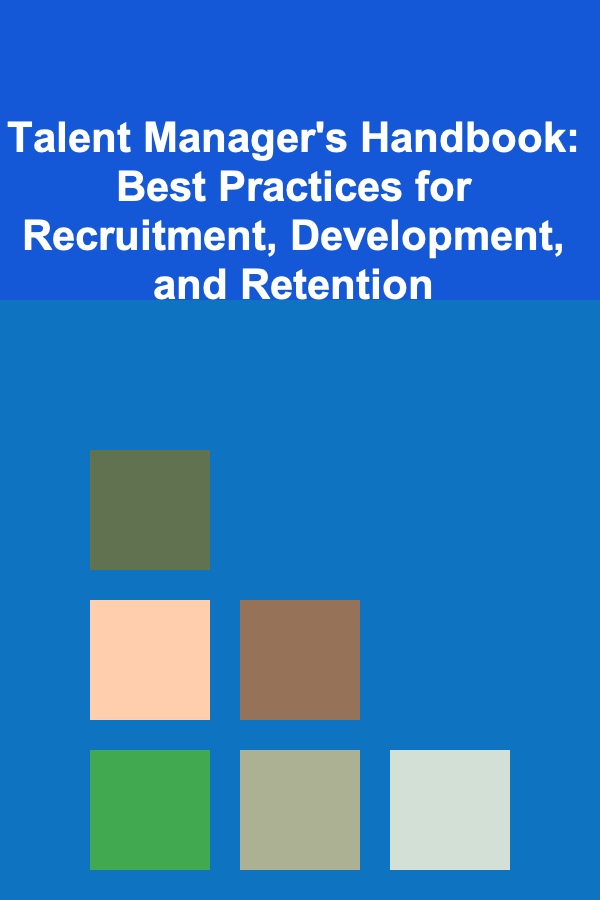
Talent Manager's Handbook: Best Practices for Recruitment, Development, and Retention
ebook include PDF & Audio bundle (Micro Guide)
$12.99$5.99
Limited Time Offer! Order within the next:

Managing talent is a crucial aspect of any organization's success. The ability to recruit, develop, and retain top talent not only boosts performance but also fosters a positive organizational culture. As companies increasingly compete for the best employees, talent management becomes a strategic function, directly influencing growth and innovation. This comprehensive guide will provide actionable best practices for talent managers to navigate recruitment, development, and retention challenges effectively.
Recruitment: Attracting the Right Talent
Recruitment is the first step in talent management, and it is critical to ensure that the right people are brought into the organization. A structured and thoughtful recruitment process can help avoid costly mistakes and improve the quality of hires.
1. Define Clear Job Roles and Requirements
A key to attracting the right candidates is clarity in job descriptions. Talent managers must work with department heads to define clear, realistic expectations of the roles. Here are some best practices:
- Job Descriptions: Be specific about job responsibilities, required qualifications, and key competencies. Use clear language that reflects the organization's values and culture.
- Essential Skills vs. Nice-to-Haves: Avoid overloading job descriptions with an exhaustive list of qualifications. Focus on the essential skills needed to succeed in the role.
- Cultural Fit: Emphasize the importance of cultural fit in the recruitment process. Candidates should align with the organization's values, mission, and work environment.
2. Utilize Data and Analytics for Targeted Sourcing
Modern recruitment should be data-driven. Talent managers should utilize data analytics to understand where top candidates are located and identify the most effective recruiting channels. This can include:
- Hiring Trends: Use historical data to identify patterns and trends in successful hires, including their backgrounds and sources of recruitment.
- Social Media and Job Boards: Leverage platforms such as LinkedIn, Indeed, and Glassdoor, while exploring niche job boards specific to the industry.
- Employee Referrals: A strong referral program not only helps find high-quality candidates but can also help with cultural alignment. Encourage current employees to refer people they believe would be a good fit.
3. Implement Structured Interview Processes
Structured interviews reduce bias and improve the consistency of hiring decisions. Talent managers should adopt a standardized interview process that includes:
- Behavioral Interviewing: Focus on past experiences and how candidates handled specific situations relevant to the role. For example, "Tell me about a time when you had to deal with a difficult client."
- Skills Assessment: Include practical exercises or assessments to measure job-related skills. This could be a technical test, case study, or role-playing scenario.
- Team Involvement: Involve team members who will be working closely with the candidate in the interview process. This not only helps assess technical fit but also ensures the candidate will be able to integrate into the team culture.
4. Employer Branding: Showcasing Company Culture
In today's competitive job market, an organization's brand plays a significant role in attracting top talent. Employer branding should reflect the company's values, culture, and work environment. Key elements include:
- Company Website: Ensure that your careers page clearly highlights the benefits of working for the organization, employee testimonials, and company values.
- Social Media: Use platforms like LinkedIn, Instagram, and Twitter to showcase a behind-the-scenes look at the company. Share stories of employee achievements and the overall work environment.
- Employee Reviews: Encourage employees to leave positive reviews on platforms like Glassdoor and Indeed, as job seekers often turn to these platforms to gauge potential employers.
Development: Growing Talent Within the Organization
Once the right people are hired, the focus shifts to developing them. Employee development ensures that employees have the necessary tools to succeed in their roles and continue progressing within the organization.
1. Create Personalized Development Plans
Each employee has unique strengths, aspirations, and development needs. A one-size-fits-all approach does not work for effective employee development. Talent managers should:
- Assess Strengths and Weaknesses: Conduct performance reviews to identify areas where employees excel and where they may need additional support.
- Career Mapping: Work with employees to develop personalized career plans. Set realistic, achievable goals and establish a path for growth within the organization.
- Learning and Development Opportunities: Encourage employees to attend workshops, training sessions, and conferences relevant to their roles. Ensure they have access to resources that align with their career development goals.
2. Invest in Continuous Learning and Skill Development
A commitment to continuous learning keeps employees engaged and ensures that the organization remains competitive. Consider implementing the following strategies:
- Online Learning Platforms: Offer access to platforms such as Coursera, Udemy, or LinkedIn Learning for employees to acquire new skills or deepen their expertise in a specific area.
- Mentorship Programs: Pair high-performing employees with senior leaders or external mentors to encourage knowledge sharing and career guidance.
- Cross-Training: Allow employees to gain exposure to other roles within the organization to build new skills and increase their versatility.
3. Performance Reviews: Constructive Feedback for Growth
Performance reviews are not just a means of assessing past performance---they are an essential tool for development. Effective performance reviews should:
- Be Regular and Ongoing: Move away from annual reviews and establish a more frequent cadence of feedback. Quarterly check-ins allow for continuous growth and adjustment.
- Focus on Development, Not Just Evaluation: Frame feedback in a way that helps employees grow. Discuss both strengths and areas for improvement, but always in a constructive manner.
- Use 360-Degree Feedback: Incorporate feedback from colleagues, managers, and direct reports to give a comprehensive view of the employee's performance.
Retention: Keeping Top Talent
Once you've recruited and developed your employees, the next challenge is retention. High employee turnover can be costly and disruptive, so creating an environment that supports employee satisfaction and long-term commitment is essential.
1. Foster a Positive Work Environment and Culture
Company culture has a significant impact on employee retention. To build a supportive and inclusive culture:
- Transparent Communication: Keep employees informed about company goals, performance, and any changes that may affect them. A transparent culture fosters trust.
- Work-Life Balance: Encourage a healthy work-life balance by offering flexible working hours, remote work options, and sufficient paid time off.
- Recognition and Appreciation: Regularly acknowledge and celebrate employees' achievements. A simple "thank you" or a more formal recognition program can significantly enhance employee morale.
2. Offer Competitive Compensation and Benefits
Compensation goes beyond salary. A comprehensive benefits package can be a major deciding factor in retaining employees. Consider the following:
- Salary Benchmarking: Regularly review industry salary standards to ensure your compensation packages are competitive.
- Health and Wellness Benefits: Provide comprehensive healthcare, dental, and mental health benefits to support employees' well-being.
- Retirement Plans and Bonuses: Offer robust retirement options and incentive programs, such as performance-based bonuses or stock options, to encourage long-term loyalty.
3. Provide Opportunities for Career Advancement
Top talent wants to grow within the organization, so offering clear career advancement opportunities is crucial for retention. Implementing the following can help:
- Internal Mobility: Encourage employees to explore new roles or departments within the company. Internal promotions not only increase retention but also build employee loyalty.
- Leadership Development Programs: Identify potential leaders within the organization and invest in leadership development programs to groom them for higher positions.
- Succession Planning: Establish a clear succession plan to ensure that employees see a path forward and understand how they can grow within the company.
4. Exit Interviews: Learn from Departing Employees
While it's important to focus on retention, some employees will inevitably leave. Use this as an opportunity to learn:
- Conduct Exit Interviews: Understand why employees are leaving by asking open-ended questions about their experience, career growth, and reasons for departure.
- Identify Patterns: Analyze exit interview data to identify trends. If multiple employees cite similar reasons for leaving (e.g., lack of growth opportunities or poor work-life balance), it may signal areas for improvement in the organization.
Conclusion
Talent management is an ongoing process that requires a strategic, thoughtful approach at every stage---recruitment, development, and retention. By defining clear job roles, utilizing data for recruitment, providing personalized development plans, fostering a supportive work environment, and offering competitive compensation, talent managers can create a cycle of continuous growth and success. Prioritizing these best practices will not only help attract and retain top talent but also contribute to the long-term success of the organization.

How to Decorate Your Home for a Romantic Date Night Party
Read More
How to Keep Your Browser Bookmarks Organized
Read More
How to Make a Checklist for Backing Up Your Website Regularly
Read More
How to Make a Small Gathering Feel Special
Read More
How to Set Up a Play Area for Your Pet in Your Home
Read More
How to Deal with Financial Stress
Read MoreOther Products

How to Decorate Your Home for a Romantic Date Night Party
Read More
How to Keep Your Browser Bookmarks Organized
Read More
How to Make a Checklist for Backing Up Your Website Regularly
Read More
How to Make a Small Gathering Feel Special
Read More
How to Set Up a Play Area for Your Pet in Your Home
Read More